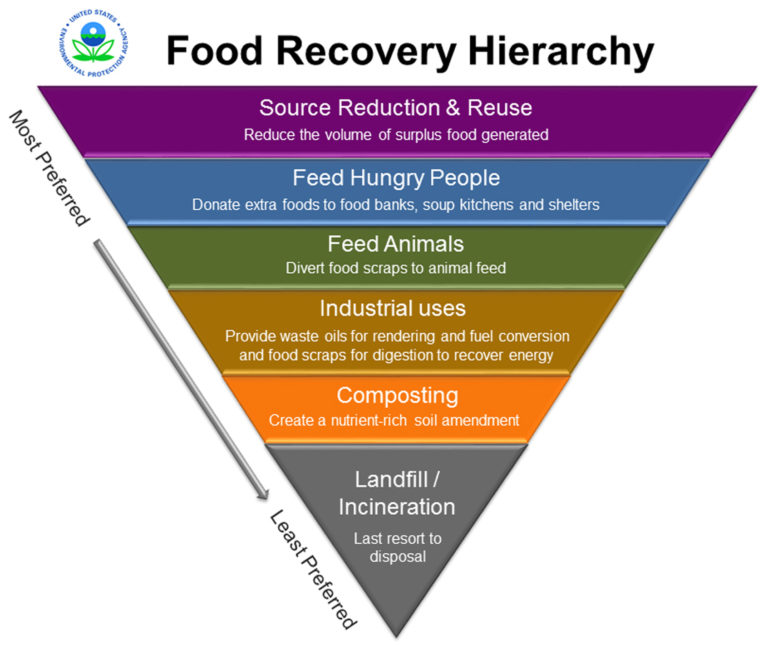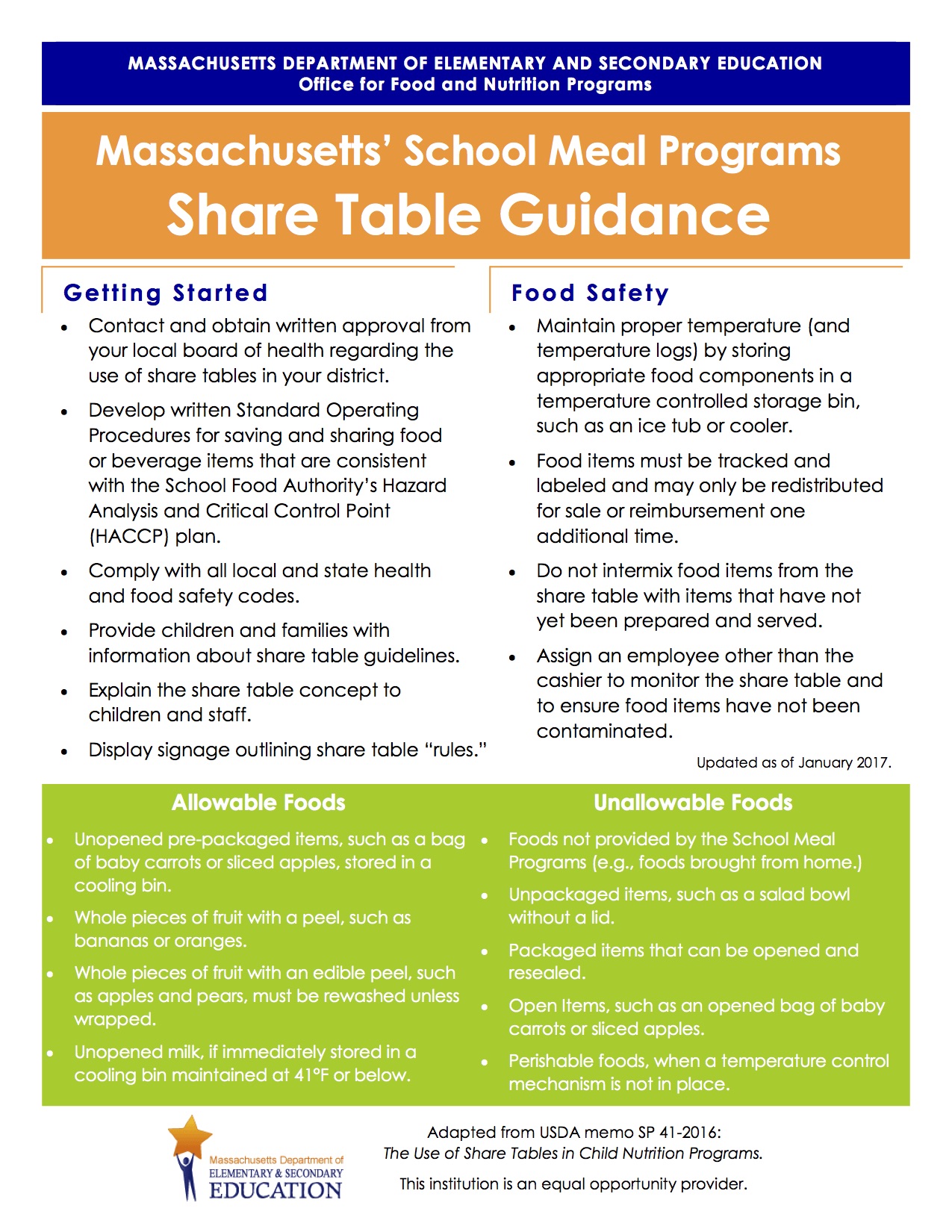EPA’s Food Recovery Hierarchy
https://www.epa.gov/sustainable-management-food/food-recovery-hierarchy
In the United States, food waste is a growing problem. Currently, about 40 percent of food is thrown away without any effort to divert it from the landfill. By weight, 63 million tons of food are wasted in the US alone every year. Not only is this behavior a gross misuse of food, but growing, processing, and transporting food is a major draw on resources. Food waste alone consumes 21 percent of all freshwater, 21 percent of landfill volume, and 19 percent of cropland (ReFED, 2018). The energy the US wastes on discarded food in a year is about twice as much energy Switzerland uses in a year (Webber, 2010) . Meanwhile, one in seven Americans are food insecure, meaning they lack reliable access to affordable, nutritious food (USDA, 2017). Due to the scale of this problem, the EPA has created a Food Recovery Hierarchy, a comprehensive graphic that outlines preferred food recovery techniques, with feeding hungry people and source reduction being the best practices.
Of the $218 billion worth of food wasted every year in the US, $1.2 billion is from school lunches (Bloom, 2016). In a study of four Boston schools, 26.1% of the food budget was thrown away by middle school students annually, not including the extra food that was never served (Cohen, 2013). While school lunch waste makes up a fraction of the wasted food in the US, it is an imperative problem to address. The K-12 educational system is an incredibly important piece of the American society, for it shapes the minds of its young generations. What these students learn in school can develop their passions, their habits, and their understanding of the world-- including the problems it faces. Allowing such waste in the school system teaches children that food is garbage, disposable and of little value. The USDA has introduced the Food Waste Challenge, a food waste reduction challenge for schools to participate in. Some schools have taken major steps towards reducing food waste and making students apart of the process so they can continue the legacy.
How You Can Have a Role in Change
Addressing food waste is a new and growing issue, but school administration can often be too busy to tackle the problem. So, it is often up to inspired community members to spark the change they would like to see. Wellesley, Massachusetts has an exemplary food waste reduction system, with programs including food share tables in elementary schools and a food donation system. These food recovery efforts began with a few concerned parents, teachers, and a motivated Food Service Director. From that grassroots beginning, food recovery projects have sprouted up in all K-12 schools in the Wellesley school district.
In the elementary schools, one parent took a special interest in food waste and was able to spark interest amongst fellow parents. With the help of custodians and the Bates Elementary School principal, they began looking into how to reduce consumer waste with their young students. To start, an experiment was conducted to discover what exactly was being thrown away by examining their waste. After this initial waste audit, Matt Delaney, the school’s Food Service Director from Whitsons Culinary Group, jumped on board. Three important steps were then taken:
Food services cut back on the food that was not being sold.
Kitchen staff went through a training process on how to package food eligible for donation.
Food that was not being sold or even put out was packaged up and taken by volunteers to food pantries.
Today, excess prepared food is frozen and then picked up by Food for Free, a food rescue organization, every two weeks and taken to nonprofits in need of food. Since then, Mr. Delaney has made great efforts to tailor meals and portions so that food waste is minimized. Future goals include expanding the school’s reusable “green” food container supply and introducing food waste composting to all cafeterias.
Green Containers used by Wellesley Public Schools. Source: Matt Delaney, Whitsons Culinary Group
After learning that the school was throwing away edible food in the initial student led waste audit, Bates Elementary School began a “share table.” Share tables (often found in elementary schools) are areas where students can leave their unopened food so that it can be redistributed. At Bates, students leave their unopened food on a specific table after lunch so it can be redirected to students in the after school program, teachers, and town departments such as Public Works. The program has been expanded to a few other Wellesley elementary schools.
In Wellesley elementary schools, parents and the Food Service Director played key roles in inspiring and implementing the food rescue program. A hope for the future in middle and high schools is that students may be inspired to address food waste and go beyond food donations and share tables. For example, students can examine why it is important to conserve food and understand the causes of the food waste challenge in the United States. In 2015, the U.S. Environmental Protection Agency set a goal of reducing food waste by half by 2030 (EPA, 2015). Consumer education will be a big part of reaching this goal. At schools, students can learn strategies for prevention, recovery and recycling of food waste. From “right sizing” portions to properly disposing of plate waste or “leftovers,” lessons about reducing and managing food waste. While curriculum is often slow to change, teachers who want to teach about food waste can work with motivated students to take the initiative to educate themselves and their peers. The links below offer some helpful suggestions for getting started.
In colleges, students often make this push. An organization called the Post Landfill Action Network (PLAN) provides resources to college students who are seeking guidance in changing the food systems at their schools. Campus Coordinators work with individual students or environmental student groups to implement waste reduction techniques such as changing portion sizes, removing trays, implementing compost, and donating unserved food. Even these students have trouble making change in consumer behavior, possibly because older students are more prone to sticking to habits. If behavioral change can be introduced at younger ages, there’s far more potential for lasting differences in how people consume their food.
How to Start Food Sharing and Donations at Your School
Massachusetts Department of Elementary and Secondary Education Guide to Share Tables https://thegreenteam.org/wp-content/uploads/2014/04/Share-Table-Guidance.pdf
Fortunately, the Federal Government protects donors of food through the Bill Emerson Good Samaritan Food Donation Act of 1996, which encourages donations of food and grocery products to nonprofit organizations. The Act encourages donations by stating that legally, a person shall or gleaner not be subject to civil or criminal liability arising from the nature, age, packaging, or condition of apparently wholesome food or an apparently fit grocery product that the person or gleaner donates in good faith to a nonprofit organization for ultimate distribution to needy individuals” (US Cong. 104-201). Although the federal government may encourage food donations, each state and school district has different policies as to how share tables and food donations should function, if they are allowed at all. The website Food Rescue has a history of State Policy on food waste in schools, which is important to know when attempting to start a share table of your own. Some schools donate unserved prepared food by donating it to a food rescue that will distribute it to a nonprofit serving those need. Once state and local allowance is confirmed, local board of health approval is also necessary.
Other key players to work with are the food service department, custodians, and administration. Food sharing, donating, and conservation cannot be done without the help of these departments who monitor different aspects food services. Creating collaborative relationships with these people are required to the functioning of any food rescue, share, or compost operation.
Thank you Matt Delaney of Whitsons Culinary Group, Phyllis Theermann of Sustainable Wellesley, and Adina Spertus of Post Landfill Action Network (PLAN).
Written by Meggie Devlin, Intern, Boyer Sudduth Environmental Consultants LLC.
August 7, 2018
Resources for Minimizing Food Waste at your School
Federal Guidelines on the Good Samaritan Act:
Bill Emerson Good Samaritan Food Donation Act of 1996
LL.M Program in Agricultural & Food Law at the University of Arkansas Legal Guide to Food Recovery Laws:
https://law.uark.edu/documents/2013/06/Legal-Guide-To-Food-Recovery.pdf
ReFED Guide to State Laws on Food Recovery
https://www.refed.com/tools/food-waste-policy-finder/
Guide to State Laws on Food Rescue in Schools
http://www.foodrescue.net/school-food-waste-policy-history.html
REFERENCES
Bloom, J. (2016). Schooling Food Waste: How Schools Can Teach Kids to Value Food. Retrieved August 7, 2018, from Food Tank website: https://foodtank.com/news/2016/11/schooling-foo d-waste-how-schools-can-teach-kids-to-value-food/
Cohen, J., Richardson, S., Austin, S., Economos, C., & Rimm, E. (2013). School lunch waste among middle school students: nutrients consumed and costs. PubMed, 44(2).
Cuellar, A., Webber, E. (2010). Wasted Food, Wasted Energy: The Embedded Energy in Food Waste in the United States. Environmental Science & Technology. 2010 44 (16), 6464-6469.
Food Security in the US: Measurement. (2017, October 4). In USDA: Economic Research Service. Retrieved August 7, 2018, from https://www.ers.usda.gov/topics/food-nutrition-assistance/food-security-in-the-us/measurement/
The Multi-Billion Dollar Food Waste Problem. (2018). Retrieved August 7, 2018, from ReFED website:https://www.refed.com/?sort=economic-value-per-ton
United States, Congress, Senate. Bill Emerson Good Samaritan Food Donation Act. Government Printing Office, 1996. 104th Congress, Senate Bill 104-210.
United States 2030 Food Loss and Waste Reduction Goal. (2015). In United States EPA. Retrieved from https://www.epa.gov/sustainable-management-food/United-states-2030-food-loss-and- waste-reduction-goaf




